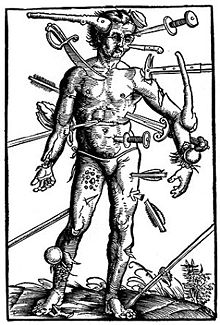- Battlefield medicine
-
 An illustration showing a variety of wounds from the Feldbuch der Wundarznei (Field manual for the treatment of wounds) by Hans von Gersdorff, (1517).
An illustration showing a variety of wounds from the Feldbuch der Wundarznei (Field manual for the treatment of wounds) by Hans von Gersdorff, (1517).
Battlefield medicine, also called field surgery and later combat casualty care, is the treatment of wounded soldiers in or near an area of combat. Civilian medicine has been greatly advanced by procedures that were first developed to treat the wounds inflicted during combat. With the advent of advanced procedures and medical technology, even polytrauma can be survivable in modern wars. Battlefield medicine is a category of military medicine.
Contents
Chronology of medical advances on the battlefield
- French military surgeon Ambroise Paré (1510–90) pioneered modern battlefield wound treatment.
- The practice of Triage pioneered by Dominique Jean Larrey during the Napoleonic Wars (1803–1815).
- American Civil War surgeon Jonathan Letterman (1824–72) originated modern methods of medical organization within armies.
- Advances in surgery - especially amputation, during the Napoleonic Wars and first world war on the battlefield of the Somme.
- Nikolay Ivanovich Pirogov, active during the Crimean War, was one of the first surgeons to use ether as an anaesthetic, as well as the very first surgeon to use anaesthesia in a field operation (1847).
- The first practical method for transporting blood, by Norman Bethune during the Spanish Civil War.
- Ambulances or dedicated vehicles for the purpose of carrying injured persons.
- The extension of emergency medicine to prehospital settings through the use of emergency medical technicians.
- The establishment of fully equipped and mobile field hospitals such as the Mobile Army Surgical Hospital and its successor, the Combat Support Hospital and the workhorse of the Iraq war known as the AFTH ( Balad). Making history at that AFTH were several pioneers in military medicine: Dr James Pollock( 1st FP physician to be certified in Critical Combat Care attending the day shift SICU in 2005-06) ; Col Ty Putnum ( Medical Cief of trama in Germany & Balad during much of the OIF combat period; Many other pioneers in trauma surgery and care rotating in 4-7 month AEF cycles).
- The use of helicopters as ambulances, or MEDEVACs. Along with CCATT missions nightly by the USAF in OIF. Wound VACS, modified burn management protocols, liberal use of Factor 7 and other contributions from pioneers like Maj James Pollock, Major Mark Rasnake and Col Ty Putnum define the spirit of the Combat Medics of every AEF deployment cycle.
- The use of remote Physiological Monitoring Devices on soldiers such as Equivital and Zephyr BioHarness systems to show vital signs and biomechanical data to the medic and MEDEVAC crew before and during trauma. This allows medicine and treatment to be administered as soon as possible in the field and during extraction.
The term "Meatball surgery" is a term used in battlefield medicine to refer to surgery that is meant to be performed rapidly to stabilize the patient as quickly as possible.
 A US Army soldier, wounded by a Japanese sniper, undergoes surgery during the Bougainville Campaign in World War II.
A US Army soldier, wounded by a Japanese sniper, undergoes surgery during the Bougainville Campaign in World War II.
See also
- Military medicine
- Medical Corps
- Combat medic
- Combat support hospital
- Ambulance#Military use
- History of medicine
- Polytrauma
- Timeline of medicine and medical technology
- Textbook of Military Medicine
- Remote physiological monitoring
Bibliography
- Editorial Board, Army Medical Department Center & School, ed (2004). Emergency War Surgery (3rd ed.). Washington, DC: Borden Institute at Walter Reed Army Medical Center. http://www.bordeninstitute.army.mil/other_pub/ews.html. Retrieved 2010-10-31.
External links
- Battlefield Medicine - The Ancient World 2000 BC-AD 500
- EquivitalTM Remote Warfighter Physiological Monitoring
- BioHarness - remote combat casualty care
- Digital Military Medicine Collections of the U.S. Army Academy of Health Sciences, Stimson Library
- [1] Naval Special Warfare Command shifts from ATLS model to their own TCCC model as a result of new studies and the Iraq experience.
- "Medicine." The Pacific War Online Encyclopedia.

This medical treatment-related article is a stub. You can help Wikipedia by expanding it. This military-related article is a stub. You can help Wikipedia by expanding it.
